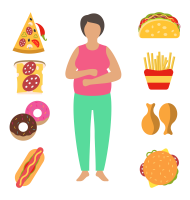Content may contain advertising or affiliate links.
Calories are a unit of measurement used to calculate energy content of food products. Each gram of fat provides nine calories; four each come from sugar and protein sources, and two come from alcohol consumption.

What Are Calories?
Calories are units of energy. They measure how much energy comes from eating and drinking foods as well as engaging with your surroundings, so in order to maintain a healthy weight it’s important to balance out how many calories are taken in and burned off by exercising or through daily activity.
Nicolas Clement-Desormes first coined the term calorie in 1824 in Le Producteur journal, although its usage would not become widespread until Karl Voit established one of the first laboratories for measuring human energy use. By then, both large or kg-calories and smaller “work calories” had become established energy units. English dictionaries did not yet include their prefixes.
Today, calories remain the standard measurement of food energy and are often referred to as kilocalories or kJ. Unfortunately, focusing solely on calories alone can lead to weight gain or loss, without considering your nutritional requirements and preferences.
Calories Needed
People require a certain number of calories in order to sustain healthy energy levels and prevent weight gain or loss. When someone consistently exceeds this quota, their weight increases. Conversely, when they ingest less calories than necessary they will experience weight loss.
Dietary guidelines suggest adults should consume between 1,600-3,000 calories daily. The exact number will depend on each individual’s age, gender and activity level. There are too many variables to cover in a simple article.
Consider goals when measuring calories. Weight loss may require fewer calories, while gaining muscle mass may require additional calories.
The first step in determining your calorie needs is to calculate your Basal Metabolic Rate (BMR). BMR represents the number of calories your body requires at rest to maintain essential bodily functions such as breathing, circulation, and cell production. Several formulas, such as the Harris-Benedict equation, can help you estimate your BMR based on factors like age, gender, weight, and height.
Once you have calculated your BMR, the next step is to factor in your activity level. This is crucial because it accounts for the calories burned during physical activities such as exercise, walking, or even standing. Assigning an activity level multiplier (ranging from sedentary to highly active) to your BMR estimate will give you a more accurate representation of your calorie needs.
Calories In Food
Calorie-rich foods provide energy and are necessary to sustain proper body functioning. Working with your healthcare provider or registered dietitian is critical in identifying your specific caloric requirements in each stage of life.
Calories can be found in food and beverages from three sources of energy, carbohydrates, proteins and fats. When counting calories, remember that each calorie represents one unit of energy.
A gram of carbs provides four calories, while one gram of protein offers 8 and one of fat provides 9. When considering food products’ calorie counts, take note of how many other nutrients they also provide. This concept is known as “nutrient density.” These nutrient-dense options contain vitamins, minerals and other essential vitamins your body requires without adding extra calories. Some examples of such food sources would include whole grains, fruits and vegetables.
Count Calories
Tracking calories is an integral component of reaching weight loss goals successfully. By keeping tabs on both the number of calories you are eating and those burned through exercise, this practice provides an effective means of tracking progress towards healthy weight management goals.
An expert registered dietitian or certified nutritionist can use your weight, height and health history to suggest an ideal daily calorie allowance for you. An online calorie calculator may also assist in this regard.
When it comes to counting calories, it can be done easily by keeping a food journal or using an app on your phone. Simply write down everything that you eat throughout the day including snacks and beverages. Use a measuring cup, scale or portion size guide to obtain factual data on the foods you are consuming.

Calorie Deficit
To succeed at weight loss, you need to create a calorie deficit by consuming fewer calories than your body burns. This may involve restricting how many calories you eat each day, or increasing physical activity to burn additional calories. A moderate deficit is safe for most people and when maintained can promote healthy weight loss, while an extreme deficit could even lead to starvation, and promote eating disorders.
The math is simple, but the implementation may be more difficult. You want to get enough calories while considering several factors, such as food groups, food preferences, and expected energy expenditure.
To create a calorie deficit, first understand your maintenance calories. These are the daily caloric needs for basic functions such as breathing, heartbeat and movement that your body requires in order to function effectively.
Attaining a calorie deficit begins by selecting nutritious food choices. Focus on selecting foods low in calories, fat and high in fiber that provide essential nutrition to the body while feeling satiated.
Understanding how to determine how many calories you need is a fundamental step towards achieving a healthy lifestyle. By calculating your Basal Metabolic Rate, factoring in your activity level, and considering your specific goals, you can tailor your calorie intake to meet your individual needs.
